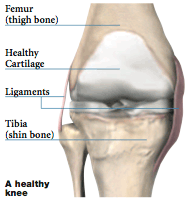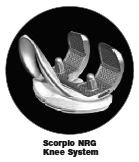Are You Considering Knee Replacement Surgery?
Each patient is unique, but generally candidates for knee replacement surgery have:
- Pain severe enough to restrict not only work and recreation, but also the routine activities of daily living
- Pain that is not relieved by more conservative methods of treatment, such as reduced activity, medication or physical therapy
- Significant joint stiffness and loss of mobility
- X-rays that show advanced arthritis or other degenerative problems
The National Institutes of Health recently concluded that knee replacement surgery is “a safe and cost-effective treatment for alleviating pain and restoring function in patients who do not respond to non-surgical therapies.” 1
Not all knee replacements are the same
Your doctor has selected Scorpio® because he/she feels it’s a good fit for you and your lifestyle, and because your doctor knows that over half a million Scorpio® knees have been used successfully worldwide during the past decade. The Scorpio NRG® Knee System was designed to provide greater stability than other knee replacements available today.
As you read, make a note of anything you don’t understand. Your doctor will be happy to answer your questions so that you’ll feel comfortable and confident with your chosen treatment plan.
 Knee Basics: What You Need to Know
Knee Basics: What You Need to Know
Knee Anatomy and Function
The knee is the largest joint in the body and is central to nearly every routine activity. The knee joint is formed by the ends of three bones: the lower end of the thigh bone (femur), the upper end of the shin bone (tibia), and the knee cap (patella). Thick, tough tissue bands called ligaments connect the bones and stabilize the joint. A smooth, plastic-like lining called cartilage covers the ends of the bones and prevents them from rubbing against each other, allowing for flexible and nearly frictionless movement. Cartilage also serves as a shock absorber, cushioning the bones from the forces between them. Finally, a soft tissue called synovium lines the joint and produces a lubricating fluid that reduces friction and wear.
 Arthritis: The Leading Cause of Knee Pain
Arthritis: The Leading Cause of Knee Pain
One of the most common causes of knee pain and loss of mobility is the wearing away of the joint’s cartilage lining. When this happens, the bones rub against each other, causing significant pain and swelling – a condition known as osteoarthritis. (Trauma or direct injury to the knee can also cause osteoarthritis.) Additionally, without cartilage there is no shock absorption between the bones in the joint, allowing stress to build up in the bones and contributing to pain.
Knee Replacement
Knee replacement is a surgical procedure – performed in the US since the 1960s – in which a diseased or damaged joint is replaced with an artificial joint called a prosthesis. Made of metal alloys and high-grade plastics (to mimic the function of bone and cartilage, respectively), the prosthesis is designed to move just like a healthy human joint.
 Over the years, knee replacement techniques and instrumentation have undergone countless improvements. Today, knee replacement is one of the safest and most successful types of major surgery. According to the American Academy of Orthopaedic Surgeons, more than 90% of people who have total knee replacement experience significant pain relief, improved mobility and a better overall quality of life.2
Over the years, knee replacement techniques and instrumentation have undergone countless improvements. Today, knee replacement is one of the safest and most successful types of major surgery. According to the American Academy of Orthopaedic Surgeons, more than 90% of people who have total knee replacement experience significant pain relief, improved mobility and a better overall quality of life.2
The Scorpio NRG® Knee System
Most people take their knees for granted. They understand that knees, like hinges, enable legs to bend for walking, running, climbing stairs and sitting, but they don’t usually think about the complex system of tendons, ligaments, muscles and bones that allow normal movement. They also don’t think about how the full weight of their body is transferred through the knee to allow them to walk smoothly, almost effortlessly at times.
 Designed to help increase motion and decrease post op pain
Designed to help increase motion and decrease post op pain
While traditional knee replacements rely on a mechanism that requires muscles to work harder, the single radius of the Scorpio NRG® knee helps enable a full range of movement faster.3 This design also allows for better quadricep function and less anterior knee pain after surgery.3 The potential for less pain and improved muscle function can translate into greater confidence with every step.
Better Fit
With an expanded range of sizing options, your doctor can better tailor the Scorpio NRG® implant to your individual anatomy.
What Typically Happens During the Surgery
In knee surgery, the knee is flexed and the leg suspended. One muscle is separated to expose the femur (thigh bone); later, the tibia (shin bone) is exposed. The damaged surfaces at the end of the thigh bone are trimmed to shape it to fit inside the total knee prosthesis. The shin bone is cut flat across the top and a hole is created in the center to hold the stem of the tibial component. If needed, the kneecap is trimmed and the patellar component attached. At various points during surgery, the alignment, function and stability of the knee joint are evaluated and required adjustments are made. The prosthesis components are cemented into place, any contracted ligaments are released, the mid-vastus muscle is reconstructed and the incision is closed.
Risks Associated with Knee Replacement
But as good as the results often are, knee replacement is major surgery, and as such, there are certain risks and expectations that must be recognized. As with any major surgical procedure, patients who undergo total joint replacement are at risk for certain complications, the vast majority of which can be successfully avoided or treated. In fact, the complication rate following joint replacement surgery is very low. Serious complications, such as joint infection, occur in less than 2% of patients.4 (Other possible complications include blood clots and lung congestion, or pneumonia.) Talk to your doctor for a complete assessment of the potential risks.
Life After Knee Replacement
The vast majority of individuals who have joint replacement surgery experience a dramatic reduction in joint pain and a significant improvement in their ability to participate in the activities of daily living. However, joint replacement surgery will not allow you to do more than you could before joint problems developed. Your doctor will recommend the most appropriate level of activity following joint replacement surgery.
You Don’t Have to Live with Severe Knee Pain
You don’t have to live with severe knee pain and the limitations it puts on your activities. If you haven’t experienced adequate relief with medication and other conservative treatments, joint replacement may provide the pain relief you long for and enable you to return to your favorite activities. The ultimate goal is for you to be as comfortable as possible with your treatment option – and that always means making the best decision based on your own individual needs.
For more information visit www.aboutStryker.com.
Stryker Corporation or its divisions or other corporate affiliated entities own, use or have applied for the following trademarks or service marks: Scorpio, Scorpio NRG and Stryker. All other trademarks are trademarks of their respective owners or holders.
References:
1. National Institutes of Health Consensus Development Conference Statement: Total Knee Replacement 12/10/03.
2. American Academy of Orthopaedic Surgeons.
3. Mahoney, O.M., et al., “The Effect of Total Knee Arthroplasty Design on Extensor Mechanism Function,” JOA, Vol. 17, No. 4, 2002.
4. Hanssen, A.D., et al., “Evaluation and Treatment of Infection at the Site of a Total Hip or Knee Arthroplasty,” JBJS, Vol.80-A, No. 6, June 1998, pp. 910-922.